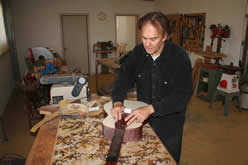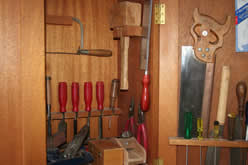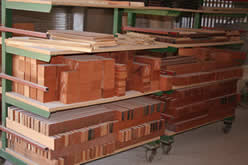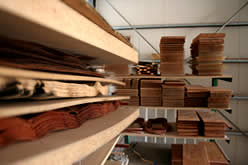




In my early teens I was a very keen budding guitarist, unfortunately not a financially independent budding guitarist, so being the type of lad that was always building models and pulling my bike apart (and succesfully rebuilding it) I decided to build an electric guitar.
This I did, with the minimum amount of tools, very little help and absolutely no experience, the end result was playable but definitely no Gibson. I was a little disappointed but I had gained a satisfaction that comes from finishing a challenge. A friend of mine saw something he liked about it and I gave it to him, which solved the disappointment and rekindled the desire to try again.
Sometime later I was lucky enough to get a Saturday morning job with a professional guitar repairer, Nick Court or Tully as most people called him . With his patience and guidance I began to learn the basics of guitar construction and repair. During the time I worked for him I bought and fully restored a second hand electric guitar and this time the end result was much better with some valuable lessons learnt along the way.
In my late teens I completed my cabinet making trade certificate with credits and went on to running my own business for over 20 years building bespoke furniture for private clients and interior designers. During that time I built many beautiful pieces using mahogany, oak, blackwood, maple and other species. I learnt lacquering, oiling and French polish techniques and importantly an understanding of timber as a medium. To really understand how timber reacts it takes years of experience, consistent acquisition of different species and life’s best teacher, trial and error.
The early years spent playing and building guitars combined with a long cabinetmaking career , have helped me immensley in building my skills as a luthier.
Years ago I realised that Mahogany and other important furniture species were seriously on the decline and that I was witnessing the end of a golden era for these wonderful timbers. Knowing well that furniture requires a lot of wood for an average sized piece, I began to doubt the long term future for my business. I clearly saw a change from the way things were done to the way they were going to be done. This change was inevitable and was the catalyst for me to make a shift, co-incidentally the guitar had come back into my life as I had started to build again for myself.
This was the begining of what is now my full time career, something that I hadn't dreamt of earlier, but something that I now cherish dearly. Building guitars is a special trade/art that allows my woodworking skills to not only be seen but now heard too.
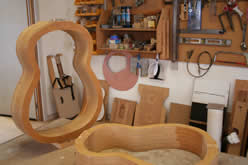

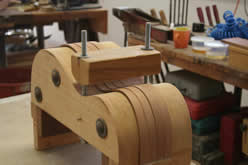

When it came to building my own guitars I felt the need to produce a non-copy, a guitar with my own plantilla and slight variations in bracing and internal structure. I started off following the traditional bracing method, then tried radial bracing and later settled on the lattice method. Consequently I have found this to be an ongoing process of subtle changes, one at a time, with an emphasis on not making too big a departure from the last guitar. This enables me to easily identify any improvements gained, without the confusion of having done too many alterations at once.
To me the classical guitar is something very special amongst guitars. It is not an easy instrument to get right and requires serious focus on the small things to keep on track. It continues to reward me with a sense of respect and achievement with each new guitar, and for me this really is the essence of " job satisfaction"

